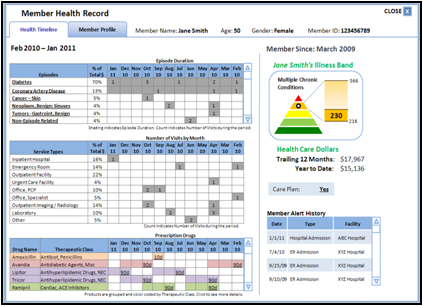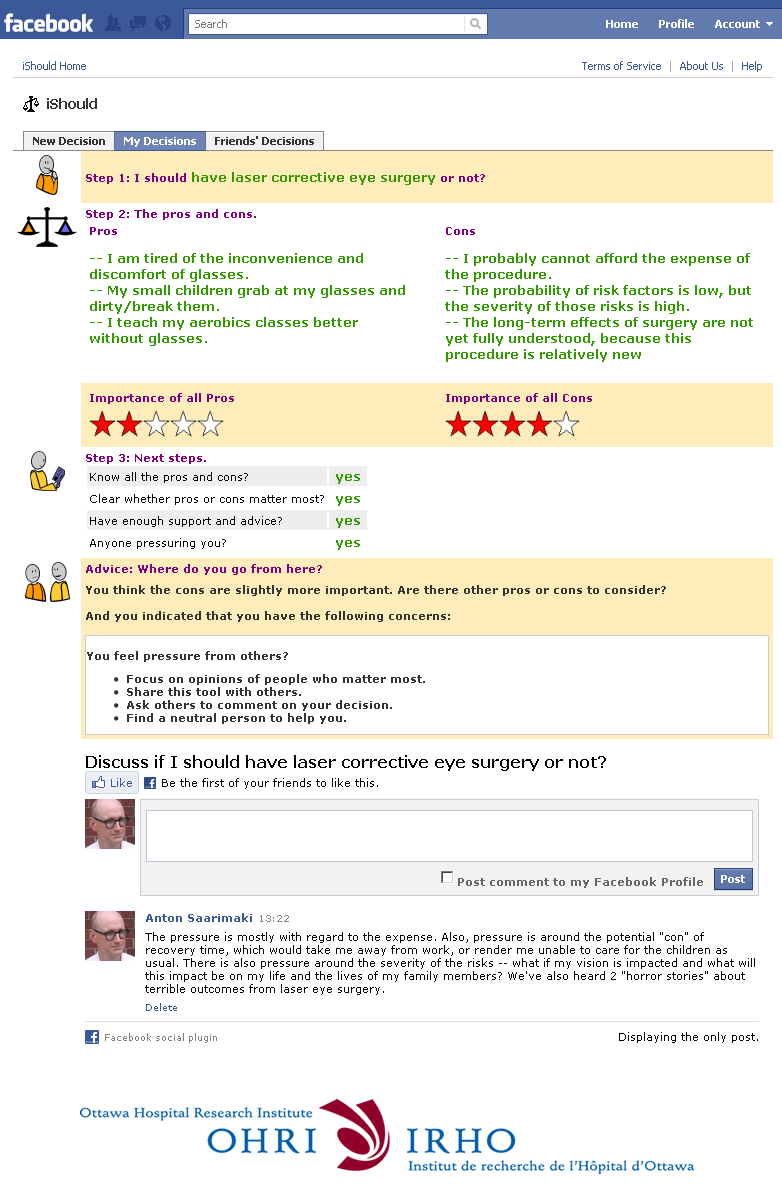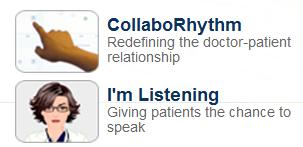Entries in shared decision making ehealth (20)
Shared Decision Making Tools Engage Consumers for Better Outcomes and a Better Experience
 September 27, 2011
September 27, 2011  CareFirst BCBS Medical Home SDM Tool
CareFirst BCBS Medical Home SDM Tool
Over two years ago, I led a panel on patient decision support tools for a large interested crowd in Boston, despite the very snowy day.
Since then, I have noticed a few key changes. Physicians are now prescribing information to patients, using the EMR to send emails with links to health resources. And innovative health plans are playing a role in bringing shared decision making tools to engage and empower their members. Health Plans have a big cost saving incentive when these tools educate their members about less invasive and less expensive options.
3 Key Engagement Drivers With Shared Decision Making Tools
While evaluating technologies for my panel on “Evolving Web & Mobile Tools to Engage Consumers in the Shared Decision Process”, I identified how three key drivers of consumer engagement are being utilized:
1. Education
These tools show the consumer what the treatment entails and share patient stories which tell them what to expect. This education reduces anxiety by putting the consumer in control to understand their health issues and presenting options to address them.
2. Evaluation
Shared Decision Making tools are ideally designed for “preference sensitive conditions” where there are multiple clinical options (For information about target conditions, see the recent report on the Dartmouth Atlas Project which was developed with The Foundation for Informed Medical Decision Making). The most effective tools offer alternatives, capture preferences and guide the consumer through the process while documenting their decisions. This helps set expectations for their experience and supports the discussion with their doctor or care coach.
3. Collaboration
As the patient and clinician/coach review the SDM summary document together, they can discuss questions, concerns and comments to make the best decision.
Health Plans Leverage Shared Decision Tools
During the panel, health plans described using Shared Decision Making tools to engage members in two key areas:
- Medical Home
Panelist Zev Lavon, PHD, Director Solution Architecture, CareFirst BCBS emphasized “the story of the patient is not their last doc visit or lab test”. CareFirst launched their Primary Care Medical Home initiative across a panel of physicians deploying communication tools to push information to patients to support the management of their chronic conditions.
-
Wellness Coaching
According to Mark L. Robitaille, MBA, Head of Care Management Support & Engagement, Aetna puts these tools into the hands of their health coaches to send emails with resources links to members or use the tools to look up information for the members without internet access.
Independent Health panelist, James J. Mis, MBA, Communications Manager, Health Care Services, described their interactive voice response campaign to inform members about viewing a shared decision making video (from Emmi Solutions) selected for their specific health interest.
Emerging Mobile SDM Tools
With a high penetration of smart phones and strong usage across minorities, health care organizations are realizing the tremendous opportunity to deploy mobile applications to engage consumers. To date, most health mobile health applications have been focused on wellness with educational information and tracking.
Panelist Changrong Ji, Senior Solutions Architect, CareFirst BCBS described the opportunity for mobile shared decision making tools. In the future, she envisions that sensors will capture the context of the consumer’s daily life, database analytics will identify patterns and machine learning will be used to help identify relevant mobile messages to send back to the consumer.
Healthwise’s View on Patient Response
During the Shared Decision Making Summit, the chairperson, Don Kemper, Healthwise’s CEO discussed the opportunity for shared decision making tools to give a “voice to the patient”. After the physician prescribes health information, the tool gathers patient’s preferences to document them in the medical record. I strongly agree with Don as he explains “there is no better way to engage the patient than to assure them that their voice will be heard in treatment and care plan decisions”.
Shared Decision Making Tools for Your Consumers
What are you doing to bring Shared Decision Making Tools to your consumers to motivate engagement in their health and wellness? I can help guide you through the process of identifing, evaluating and piloting these technologies to deliver better outcomes and a better experience for your consumers.
Evolving Web Based and Mobile Tools to Engage Consumers in the Shared Decision Making Process
 September 6, 2011
September 6, 2011

World Congress Leadership Summit on Shared Decision Making
September 23, 2011
Panel Session:
Moderator:
Sherri Dorfman, MBA, Chief Executive Officer, Stepping Stone Partners
Panelists:
- Mark L. Robitaille, MBA, Head of Care Management Support & Engagement, Aetna
- Changrong Ji, Senior Solutions Architect, CareFirst BCBS (Mobile strategy)
- Zev Lavon, PHD, Director Solution Architecture, CareFirst BCBS (Web strategy)
- James J. Mis, MBA, Communications Manager, Health Care Services, Independent Health
 care collaboration,
care collaboration,  mobile health and wellness texting,
mobile health and wellness texting,  online health and wellness coaching,
online health and wellness coaching,  patient centered medical home,
patient centered medical home,  personalization for health and wellness in
personalization for health and wellness in  Decision Support eHealth,
Decision Support eHealth,  Mobile Engagement Health & Wellness,
Mobile Engagement Health & Wellness,  Patient Decision Support,
Patient Decision Support,  Personalization eHealth,
Personalization eHealth,  shared decision making ehealth
shared decision making ehealth Ready for the Silver Tsunami?
 September 29, 2010
September 29, 2010  Last week, I attended Mass Technology Leadership Council’s event on the Emerging Technologies for the Silver Tsunami: Aging in Place through the use of Integrated Technology. The room was packed with interested stakeholders from HIT technology companies, hospitals, home health agencies and senior living communities.
Last week, I attended Mass Technology Leadership Council’s event on the Emerging Technologies for the Silver Tsunami: Aging in Place through the use of Integrated Technology. The room was packed with interested stakeholders from HIT technology companies, hospitals, home health agencies and senior living communities.
This is one of several events across the country focused on opportunities that will be brought in with the new waves of seniors.
Beginning in 2011, the oldest of the 78 million baby boomers will turn 65 years old. According to the Stanford Center on Longevity, the "number of older people (age 65 and over) will double over the next 30 years, from 40 million to 80 million, and the percentage of older people in the population will increase from 13% to 20%".
Given the size of this new segment of seniors, their education, affluence and comfort with technology, they will have a powerful impact on healthcare delivery, health plans and aging services.
Riding the Waves:
Leveraging my extensive consulting experience and knowledge about elder care technologies, I have defined five requirements for HIT solutions to meet the needs of seniors, families, caregivers and the care team.
1. Extending Solutions for Care Management
“I want my mom’s doctor to know what is really happening when she is away from his office”.
Through acquisition and partnerships, companies are combining their “point solutions” to bring new capabilities to seniors and their care circle. HIT suppliers are also proactively seeking ways to tie their solutions into the EMR and Health Information Exchange to bring needed insight to the clinician and support the medical home care team.
2. Expanding Solutions across the Care Continuum
“I do not want to have to purchase, learn and manage all different technologies as my father ages.”
There is an opportunity for health information technology firms to design their solutions with a set of capabilities that can be turned on as the senior requires the support. Considering the burden of the adult children and caregivers, the solution for this market will meet the needs of seniors across the care continuum; preventative, acute, chronic and long-term.
3. Guiding Care Decisions
“We are all taking turns caring for my father and we are exhausted since his health is deteriorating each day.”
Most of us have access to calendars and communication technologies which we can use for personal reasons. The problem is that we do not know what to expect each day and find ourselves reacting instead of planning for the care of our loved one. When we have a few minutes, we call our friend who just went through this with her mom. Think about how social networking can be leveraged to help families anticipate, plan and make the best decisions with the guidance of experts and other experienced caregivers.
4. Supporting Service Delivery
“I need to know what our caregivers are observing and be alerted when mom needs additional care.”
Whether they are busy raising their own families or living in another state, adult children struggle to care for their elder loved ones. Professional caregivers including home health workers can use technology to record observations of daily living and engage in shared decision making with the family.
5. Supporting Self -Management
“My dad needs to be able to manage this diabetes on a daily basis”.
With the shortage of health care professionals, older consumers need to take care of their chronic conditions and understand how to make changes when they run into many different situations common to their condition. Technology can serve as an enabler by reminding the senior to take medications and perform certain behaviors, tracking these activities, educating them what to do when these activities are missed, monitoring their vitals and alerting caregivers when problems arise.
Getting Ready for the Silver Tsunami:
As you define/refine your own product strategy for the senior market, think carefully about the steps you will take. The senior market is made up of many different “sub-segments". It is important to identify and understand how these sub-segments differ in their needs, behaviors, technology usage and preferences. This research will provide the insight to guide your product development to meet the requirements of your target audience(s).
How can you prepare for the Silver Tsunami? Learn more.
Social Media Meets Shared Decision Making with iShould
 July 27, 2010
July 27, 2010  While taking a walking this beautiful afternoon, I noticed a frail elderly woman inching forward on the sidewalk in front of me as her aide held her arm securely around the senior’s tiny waist.
While taking a walking this beautiful afternoon, I noticed a frail elderly woman inching forward on the sidewalk in front of me as her aide held her arm securely around the senior’s tiny waist.
Although you and I may not need physical support to move ahead, imagine the feeling that you are heading in the right direction, with guidance each step of the way.
During my panel last week on “New Models for Social Media”, I shared an example of an interesting approach which is at the intersection of social media and decision support. With the “iShould” application developed by the Ottawa Hospital Research Institute (OHRI), you can reach out online to your own social network to gather input for your health decision. If for example you are considering corrective eye surgery, you can bring those you trust into your decision process. On this Facebook application, you fill in the decision, list and rate the pros and cons and select friends to comment. This invites support around your decision.
I do believe that this application can be most valuable when you are asking friends who have experience with your health decision so that they can provide insightful comments for your consideration.
Patients in Control Demonstrated in MIT's New Media Medicine Group
 May 11, 2010
May 11, 2010  Recently, I sat down with Dr. John Moore, Researcher in the New Media Medicine Group of the MIT Media Lab.
Recently, I sat down with Dr. John Moore, Researcher in the New Media Medicine Group of the MIT Media Lab.
“With our CollaboRhythm, we are redefining the relationship between the patient and their doctor”, explained John. “Instead of being in control, the doctor is serving as a coach to help the patient with their care planning and delivery.”
As I watched the demo, what surprised me the most was that the patient was interacting with the flat screen displaying her information and deciding about her upcoming treatment. John described what was happening. “This is ‘shared decision making’ in action where the patient determines what changes she wants to make and even schedules her medication while the doctor is by her side providing guidance as needed.”
When the patient leaves her doctor’s office, she is ready to follow through on the plans she made. “All of the follow- up information has been pushed to the electronic devices that she will rely on. Her pill dispenser has been automatically programmed. Her mobile phone is ready to receive the reminders and the necessary sensors are in place to track her activities”, John mentions with a smile.
Next, I saw a demo of the “I’m Listening” project, designed to bring the patient into her own care management process. The patient is relaxing on a coach in her living room with a cup of coffee as she is having a conversation with an “avatar” on her flat screen television. “The avatar agent asks the patient questions to gather information for her clinician. This gives the patient more freedom to share her story at her own pace”, explains John. When the patient wants to show the sore on her foot to her doctor, she lifts her foot in front of the build- in camera to have a picture taken.
I was interested to learn that this system takes all of the information gathered including the ‘words of the patient’ as well as photos and organizes it for her next doctor's appointment which she schedules. Notice the time savings for the doctor and the convenience for the patient.
With both projects, the patient has a more proactive role in managing their own health, the doctor remains in an “expert” role and their collaboration and communication are enabled through technology.
What About You?
- What are you doing to empower consumers?
- How are you engaging consumers to share their health data with you?
- Are you gathering and organizing the consumers' health information to support care decisions?
Although MIT's patient- focused products were developed in the lab, there is so much we can learn from their approach. They put the patient in control of their health with access to information and collaboration with their clinician for guidance. Technology plays an important role of seamlessly moving the patient's information to where it is needed (e.g. devices) for further interaction. During these interactions, technology enables the collection of patient data to support shared health decisions.



